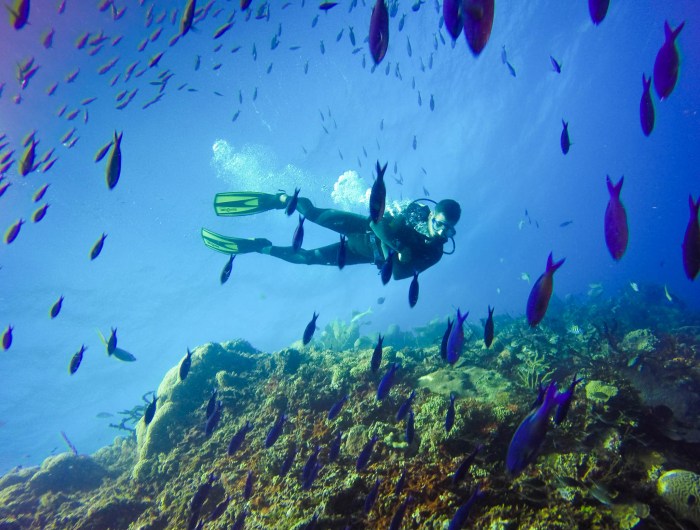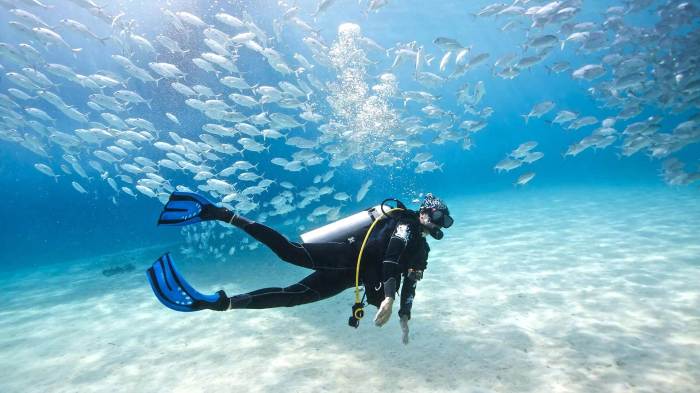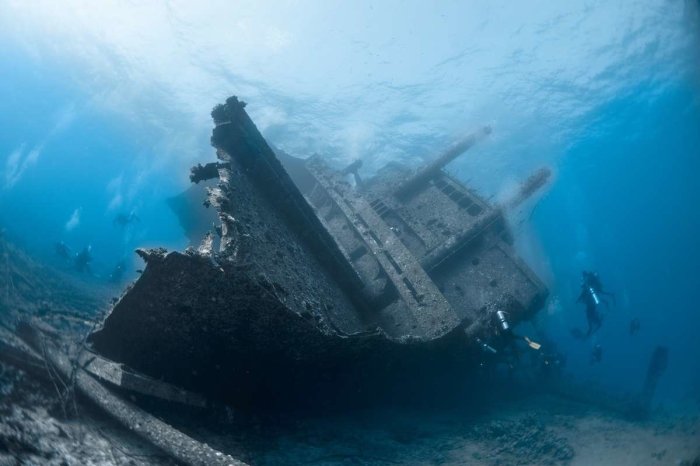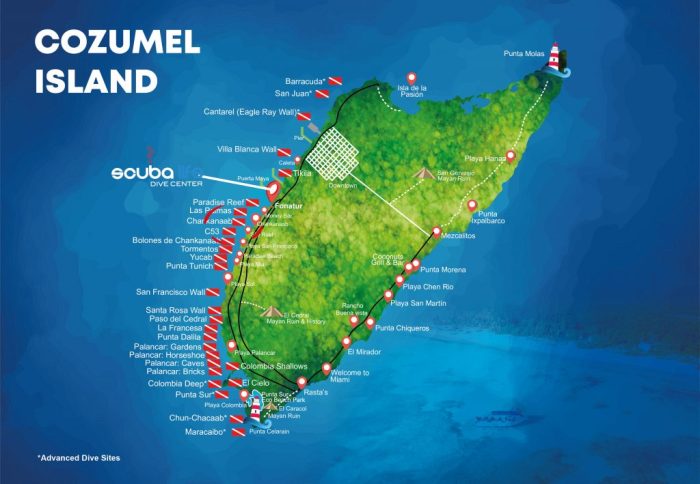As scuba diving locations take center stage, let’s embark on a journey to explore the captivating underwater world. From pristine coral reefs teeming with vibrant marine life to enigmatic shipwrecks holding secrets of the past, the allure of scuba diving beckons adventure seekers and nature enthusiasts alike.
Whether you’re a seasoned diver or just starting your underwater exploration, this comprehensive guide will immerse you in the wonders of scuba diving destinations, providing insights into the factors that make a location exceptional, the diverse types of diving available, and the essential techniques and safety protocols to ensure an unforgettable and enriching experience.
Top Scuba Diving Destinations: Scuba Diving Locations
Scuba diving offers an unparalleled opportunity to explore the underwater world, with its vibrant marine life, breathtaking coral reefs, and historic wrecks. Certain destinations stand out as top scuba diving locations due to a combination of factors, including water clarity, marine biodiversity, unique geological formations, and accessibility.
Here are the top 5 scuba diving destinations in the world, each offering its own unique experiences and attractions:
The Great Barrier Reef, Australia
The Great Barrier Reef is the world’s largest coral reef system, stretching for over 1,400 miles along the coast of Queensland, Australia. It is home to an incredible diversity of marine life, including over 1,500 species of fish, 400 species of coral, and 4,000 species of mollusks. The reef is a UNESCO World Heritage Site and one of the Seven Natural Wonders of the World.
The Red Sea, Egypt
The Red Sea is known for its crystal-clear waters and vibrant coral reefs. It is home to over 1,000 species of fish and 300 species of coral. The Red Sea is also home to several historic shipwrecks, including the SS Thistlegorm, which was sunk during World War II and is now a popular dive site.
When it comes to scuba diving locations, there are countless options to choose from around the world. From the vibrant coral reefs of the Great Barrier Reef to the underwater caves of Mexico’s Yucatán Peninsula, there’s something for every level of diver.
For those looking for a truly unique experience, check out Hello world! , a website dedicated to discovering the most awe-inspiring scuba diving destinations on the planet.
The Maldives
The Maldives is a group of over 1,000 islands in the Indian Ocean. It is known for its white-sand beaches, crystal-clear waters, and coral reefs. The Maldives is home to over 1,000 species of fish and 200 species of coral. The reefs are home to a variety of marine life, including sharks, rays, and turtles.
The Galapagos Islands, Ecuador
The Galapagos Islands are a group of volcanic islands in the Pacific Ocean. They are known for their unique wildlife, including marine iguanas, giant tortoises, and sea lions. The Galapagos Islands are also home to a variety of coral reefs and marine life. The reefs are home to over 1,000 species of fish and 300 species of coral.
Cozumel, Mexico
Cozumel is an island in the Caribbean Sea, off the coast of Mexico. It is known for its coral reefs, which are home to over 500 species of fish and 100 species of coral. Cozumel is also home to several historic shipwrecks, including the SS Mayaguez, which was sunk in 1984 and is now a popular dive site.
Types of Scuba Diving

Scuba diving encompasses a wide range of activities, each with its unique characteristics and requirements. Understanding the different types of scuba diving can help divers choose the experiences that best suit their interests and skill levels.
There are three main categories of scuba diving: recreational, technical, and cave diving. Recreational diving is the most common type, and it involves diving in relatively shallow waters, typically less than 130 feet. Technical diving involves diving deeper than recreational limits, often using specialized equipment and techniques. Cave diving involves exploring underwater caves, which requires specific training and equipment.
Recreational Diving
Recreational diving is the most accessible type of scuba diving, and it is suitable for divers of all experience levels. Recreational divers typically dive in shallow waters, and they do not require specialized equipment or training. However, recreational divers must still follow basic safety guidelines, such as diving with a buddy and staying within their depth limits.
Pros:
– Accessible to divers of all experience levels
– Relatively inexpensive
– Wide variety of dive sites available
Cons:
– Depth limits can be restrictive
– Limited visibility in some areas
– Can be crowded at popular dive sites
Technical Diving
Technical diving involves diving deeper than recreational limits, typically using specialized equipment and techniques. Technical divers must have advanced training and experience, and they must be able to handle the challenges of deep diving, such as decompression sickness and equipment failure.
Pros:
– Access to deeper dive sites
– Greater exploration opportunities
– Increased sense of accomplishment
Cons:
– Requires specialized training and equipment
– Can be expensive
– Higher risk of decompression sickness and other diving accidents
Cave Diving
Cave diving involves exploring underwater caves, which requires specific training and equipment. Cave divers must be able to navigate in dark, confined spaces, and they must be able to handle the challenges of cave diving, such as silt-outs and equipment entanglement.
Pros:
– Unique and challenging diving experience
– Opportunity to explore hidden underwater worlds
– Increased sense of adventure
Cons:
– Requires specialized training and equipment
– Can be dangerous if not done properly
– Limited visibility in some caves
Scuba Diving Equipment
Scuba diving requires specialized equipment to ensure the safety and comfort of divers underwater. The essential gear includes:
Regulator
The regulator is the most critical piece of scuba diving equipment. It reduces the high-pressure air from the scuba tank to a breathable pressure for the diver. It consists of a first stage, which attaches to the tank, and a second stage, which the diver breathes from.
Buoyancy Compensator Device (BCD)
The BCD, also known as a buoyancy control device, is worn on the diver’s back and controls the diver’s buoyancy. It is inflated with air to increase buoyancy and deflated to decrease buoyancy, allowing the diver to ascend, descend, or maintain a neutral position in the water.
Scuba Tank
The scuba tank holds the compressed air that the diver breathes underwater. It is typically made of aluminum or steel and comes in various sizes and capacities, depending on the dive time and depth.
Mask
The mask allows the diver to see clearly underwater. It covers the eyes and nose and creates an airtight seal to keep water out.
Fins
Fins are worn on the diver’s feet and provide propulsion underwater. They come in various shapes and sizes, depending on the diver’s preference and diving style.
Wetsuit or Drysuit
A wetsuit or drysuit provides insulation and protection from the cold water. Wetsuits allow some water to enter but keep the diver warm by trapping a layer of water against the body. Drysuits keep the diver completely dry but require additional insulation for warmth.
Dive Computer
A dive computer is an electronic device that monitors the diver’s depth, time, and other important information. It helps the diver stay within safe diving limits and avoid decompression sickness.
Importance of Proper Equipment Maintenance and Safety
Proper maintenance and safety of scuba diving equipment are crucial for the diver’s well-being. Regular inspection and servicing of the equipment, including the regulator, BCD, and scuba tank, ensure their proper functioning and reliability underwater. Divers should also be trained in proper equipment usage and emergency procedures to handle potential malfunctions or accidents.
Scuba diving offers a world of underwater exploration, from vibrant coral reefs to ancient shipwrecks. Discover the best scuba diving locations around the globe, where you can witness marine life in its natural habitat. Whether you’re a seasoned diver or a novice looking for your first underwater adventure, these destinations offer unforgettable experiences and memories that will last a lifetime.
Scuba Diving Techniques

Mastering scuba diving techniques is crucial for a safe and enjoyable underwater experience. These techniques include buoyancy control, navigation, and emergency procedures.
Buoyancy Control
Buoyancy control is the ability to maintain a neutral position in the water. This is achieved by adjusting the amount of air in the buoyancy compensator device (BCD).
- To ascend, add air to the BCD.
- To descend, release air from the BCD.
Navigation
Navigation skills are essential for finding your way underwater. This involves using a compass, depth gauge, and natural landmarks.
- Plan your dive route in advance.
- Use a compass to stay on course.
- Monitor your depth and time.
Emergency Procedures
Emergency procedures are crucial for handling unexpected situations underwater. These include:
- Out of air: Ascend slowly while signaling for help.
- Equipment failure: Use backup equipment or signal for help.
- Lost diver: Stay calm and follow emergency protocols.
Proper training and certification are essential for learning and practicing these techniques safely and effectively.
Scuba Diving Safety

Scuba diving is an exhilarating activity that allows us to explore the wonders of the underwater world. However, it’s crucial to be aware of the potential risks and hazards associated with this activity and take necessary safety precautions to minimize them.
Common Risks and Hazards
Some common risks and hazards associated with scuba diving include:
- Decompression sickness (DCS): This occurs when nitrogen bubbles form in the body’s tissues due to rapid ascent from depth.
- Barotrauma: This is damage to the ears, sinuses, or lungs caused by changes in pressure during ascent or descent.
- Oxygen toxicity: This can occur when breathing pure oxygen at depths greater than 20 meters.
- Nitrogen narcosis: This is a state of euphoria and impaired judgment caused by breathing nitrogen at depths greater than 30 meters.
- Hypothermia: This occurs when the body loses heat faster than it can produce it.
Safety Precautions, Scuba diving locations
To minimize these risks, divers should follow these safety precautions:
- Get certified: Obtain proper training and certification from a reputable organization.
- Dive with a buddy: Never dive alone, always have a partner.
- Plan your dive: Check weather conditions, tides, and currents before diving.
- Stay within your limits: Don’t exceed your depth or time limits.
- Ascend slowly: Allow your body to adjust to the decreasing pressure gradually.
- Use proper equipment: Ensure your scuba gear is well-maintained and fits properly.
- Listen to your body: If you experience any discomfort or symptoms, ascend immediately.
Emergency Procedures
In case of an emergency, divers should follow these procedures:
- Stay calm and assess the situation.
- Signal for help using your whistle or hand signals.
- Ascend slowly while breathing continuously.
- Seek medical attention immediately if necessary.
Scuba Diving Etiquette
Scuba diving is an activity that requires a certain level of etiquette to ensure the safety and enjoyment of all participants. These unwritten rules and customs help to create a respectful and harmonious environment both above and below the water.
It is important to behave respectfully towards other divers, marine life, and the environment. This includes:
- Respecting the rights of way of other divers.
- Avoiding touching or harassing marine life.
- Not damaging coral reefs or other underwater structures.
Dive Site Etiquette
It is also important to respect dive sites and preserve underwater ecosystems. This includes:
- Following the rules and regulations of the dive site.
- Not littering or leaving any trash behind.
- Reporting any damage or pollution to the appropriate authorities.
By following these simple rules of etiquette, scuba divers can help to ensure that the sport remains safe and enjoyable for everyone.
Scuba Diving Photography

Underwater photography captures the beauty and wonder of the underwater world. It requires specialized techniques and equipment to overcome the challenges of shooting beneath the surface.
Camera Settings
Proper camera settings are crucial for successful underwater photography. Use a wide-angle lens to capture a broader field of view. Set the aperture to f/8 or higher for increased depth of field. Adjust the shutter speed to avoid blurry images while considering the available light.
Lighting
Lighting is essential for illuminating underwater subjects. Natural light is often insufficient, so use artificial lighting such as strobes or video lights. Position the lights carefully to avoid backscatter, which can create a hazy effect in images.
Composition
Composition techniques enhance the impact of underwater photographs. Use the rule of thirds to create visually appealing shots. Incorporate negative space to emphasize the subject. Pay attention to the background and avoid distracting elements.
Respecting Marine Life
Underwater photographers have a responsibility to respect marine life and minimize their impact on the environment. Avoid touching or disturbing animals. Use natural light whenever possible and minimize the use of strobes. Practice buoyancy control to avoid damaging coral reefs.
Scuba Diving Conservation
The world’s marine ecosystems are facing numerous threats, including pollution, overfishing, and climate change. Scuba divers can play a vital role in protecting these ecosystems by adopting responsible diving practices and supporting conservation organizations.
One of the most important things scuba divers can do is to avoid touching or disturbing marine life. This can damage delicate organisms and disrupt their natural behavior. Divers should also be careful not to damage coral reefs, which are essential habitats for many marine species.
Responsible Diving Practices
- Avoid touching or disturbing marine life.
- Be careful not to damage coral reefs.
- Dispose of waste properly.
- Respect marine protected areas.
- Educate others about the importance of marine conservation.
Scuba Diving Organizations Involved in Conservation Efforts
Many scuba diving organizations are involved in conservation efforts. These organizations work to protect marine ecosystems through research, education, and advocacy.
- Project AWARE
- The Coral Restoration Foundation
- The National Marine Sanctuary Foundation
Final Thoughts
In the realm of scuba diving, every destination offers a unique tapestry of underwater wonders. Whether you seek adrenaline-pumping drift dives, tranquil encounters with gentle sea turtles, or the awe-inspiring spectacle of underwater caves, there’s a scuba diving location that will ignite your passion for exploration. Embrace the allure of the deep blue sea, and let the underwater world captivate your senses.
Top FAQs
What factors make a top scuba diving destination?
Top scuba diving destinations offer a combination of factors, including diverse marine life, pristine water conditions, unique underwater formations, and well-developed infrastructure for divers.
What are the different types of scuba diving?
Scuba diving encompasses various types, including recreational diving for leisure, technical diving for deeper depths and specialized equipment, and cave diving for exploring underwater caverns.
What are the essential scuba diving techniques?
Essential scuba diving techniques include buoyancy control for maintaining neutral underwater, navigation for finding your way underwater, and emergency procedures for handling unexpected situations.
How can scuba divers help protect marine ecosystems?
Scuba divers can contribute to marine conservation by practicing responsible diving, avoiding touching or disturbing marine life, and supporting organizations involved in conservation efforts.